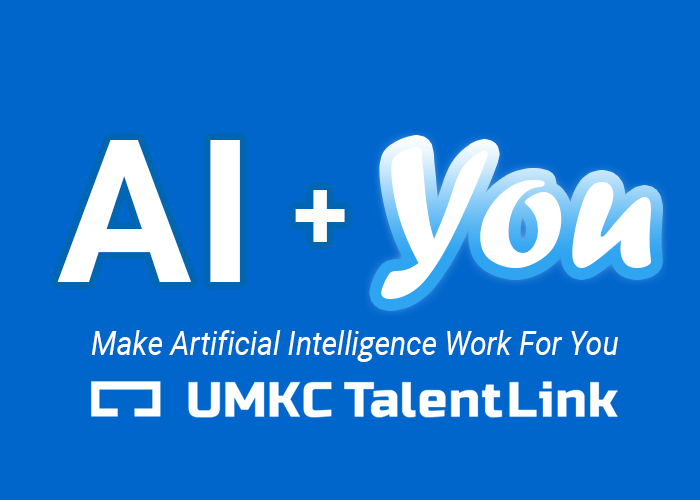homepage | Make Artificial Intelligence Work For You
June 2, 2023
June 2, 2023

UMKC TalentLink introduces AI + You, a new blog post series and newsletter covering artificial intelligence (AI) as a practical guide. It’s challenging to follow the daily flood of AI news, trends, and emerging applications. We’re here to help navigate this tech shift.
Use the form below to sign up for our newsletter AI + You. You’ll receive links to blog posts filled with helpful AI tips, tools, and trends. It’s an easy and time-saving way to stay informed, get inspired, and learn how to incorporate AI tools into your work.
AI shouldn’t be frightening.
Technology has always influenced how we socialize, communicate, work, shop, conduct business, and create. Smartphones and social media replaced landline-based phones which replaced letter writing as a way to stay in touch. Think about texting, Google Search, Netflix, Google Maps, Quickbooks, Amazon, Zoom, and Alexa. Now commonplace, these tools, products, and platforms enable us to be more efficient, enriched, and capable.
Let’s begin with some fundamental types and uses of artificial intelligence.
Artificial intelligence is an umbrella term that covers a range of technology. In simple terms, AI is “a field of computer science that focuses on creating and training machines to perform intelligent tasks.” Here’s a deeper dive into AI’s ability to “use real-time data to simulate human intelligence.”
Some benefits of using artificial intelligence include:
Learn more about Artificial Intelligence.
Machine learning enables a computer to analyze data with algorithms, “learn” without being trained, reduce errors, improve performance, and in some cases adapt to the user’s request.
You’re likely familiar with virtual assistants such as Apple’s Siri and Amazon’s Alexa. These tools use voice recognition, machine learning, and natural language processing to respond to voice requests and commands. Considered weak or narrow conversation AI, these voice assistants cannot think like humans.
Learn more about Machine Learning.
Natural language processing (NLP), a type of machine learning, enables computers to process and analyze human speech and language patterns and produce a response. In other words, computers equipped with NLP “understand text and spoken words in much the same way human beings can.”
Chatbots using machine learning and natural language processing tend to be more interactive and productive. The bot is better able to respond to a user’s needs and converse like a human.
Clinical decision support systems (CDS/CDSS) also use machine learning and NLP. In healthcare, this rapidly growing industry enables physicians to use tools that assist with complex decision-making processes. Surgeons and other healthcare providers are better able to provide diagnosis and treatment options. AI-based tools can help improve caregiver efficiency and patient outcomes.
TIP: Here’s a brief glossary of more AI-related terms.
AI’s ability to process and assess huge data sets, spot patterns, and make predictions has been a useful analytical tool for decades. In recent years, generative AI represents the next transformative and disruptive wave of artificial intelligence.
Generative AI can make things. The technology can produce words, sounds, images and video, sometimes at a level of sophistication that mimics human creativity. While extremely powerful, this form of AI cannot think like a human but can seem lifelike.
OpenAI’s popular chatbot ChatGPT and image generator DALL-E are two examples of generative AI. These tools draw on massive data sets of words and images. Learn more about how ChatGPT works.
TIP: Explore how you can use ChatGPT in your spreadsheets and documents. AI entrepreneur and advisor Allie K. Miller shared a step-by-step guide on how to access the OpenAI API in Google Spreadsheets.
Why use OpenAI in a spreadsheet? Miller suggests a few use cases.
• Marketers – Automate content generation for campaigns.
• Financial analysts – Generate insights and suggestions based on datasets to make fast, efficient data-driven decisions.
• Researchers – Quickly summarize thousands of survey responses
Hundreds of other generative AI apps have been developed and released in recent months. Here’s a handy way to stay informed.
TIP: Follow Generative AI’s posts on LinkedIn for newly released AI applications, tools, and plugins.
Email us about other AI topics you would like to learn about.